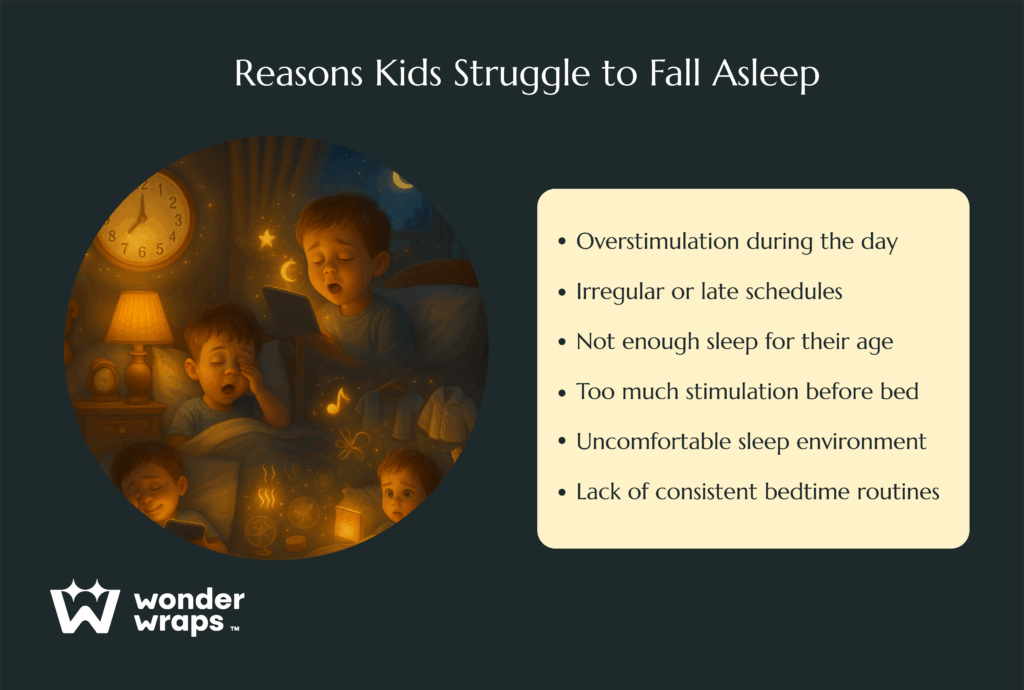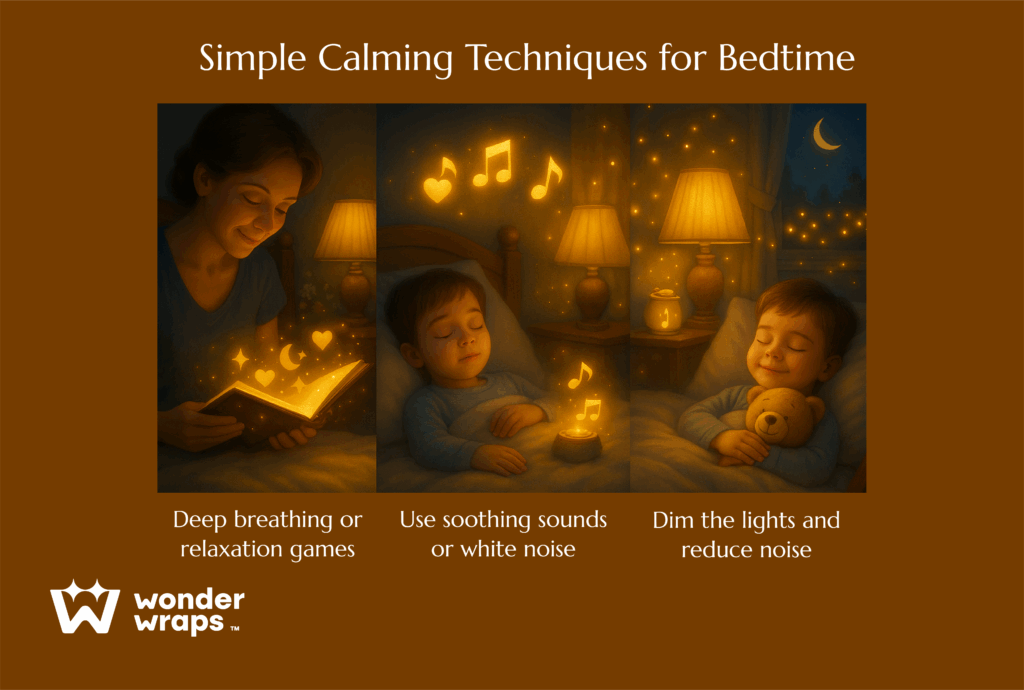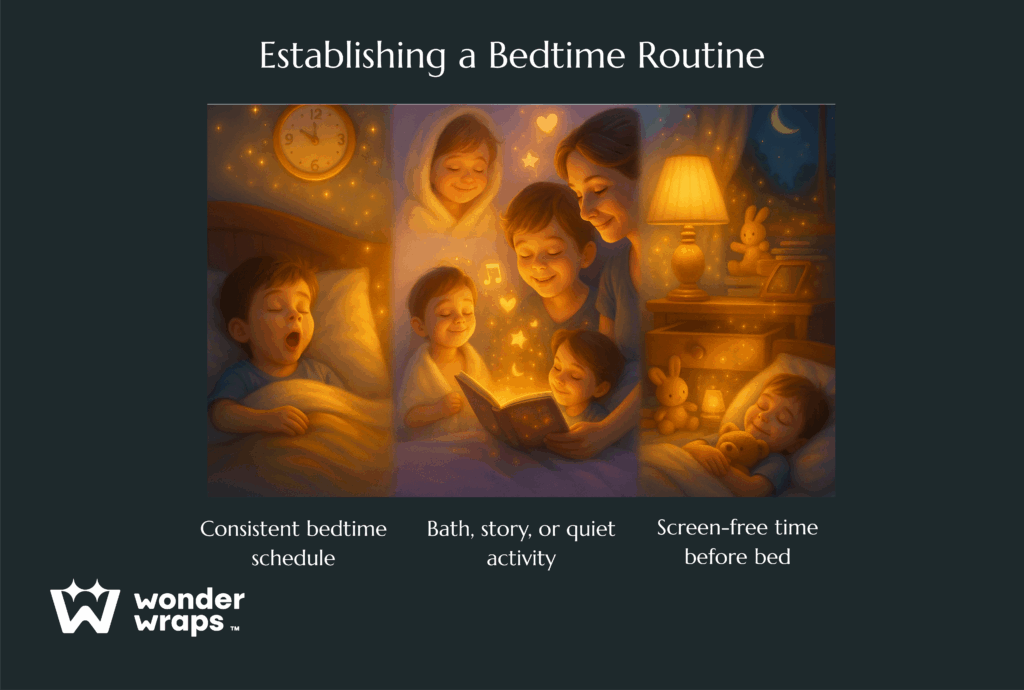Key Takeaways
- Children’s sleep difficulties often stem from overstimulation throughout the day, particularly from screen time, exciting activities, or irregular schedules.
- Consistency signals to children’s bodies that sleep time is approaching, making the transition from wake to sleep much smoother and faster.
- Personalized bedtime stories offer an especially powerful alternative to screens.
Every parent has experienced those frustrating nights when learning how to make a kid sleep instantly becomes the most important skill in the world. Whether it’s bedtime resistance, overtiredness, or simply an active mind that won’t wind down, getting children to fall asleep quickly is one of parenting’s most common challenges.
The truth is, while “instant” sleep isn’t realistic, there are proven techniques that can dramatically reduce the time it takes for your child to drift off. From creating the perfect sleep environment to establishing calming routines, these strategies work with your child’s natural sleep patterns rather than against them.
Understanding why children struggle with sleep and having a toolkit of gentle, effective methods can transform bedtime from a battle into a peaceful transition that both you and your child will appreciate.
Why Kids Struggle to Fall Asleep

Children’s sleep difficulties often stem from overstimulation throughout the day, particularly from screen time, exciting activities, or irregular schedules. Their developing nervous systems need more time to transition from active, alert states to calm, sleepy ones.
Sleep needs vary significantly by age, with toddlers requiring 11-14 hours while school-age children need 9-11 hours of sleep per night. When children don’t get adequate sleep or when bedtimes are inconsistent, their internal clocks become disrupted, making it even harder to fall asleep quickly.
Common culprits include too much stimulation before bed, uncomfortable room temperatures, irregular meal times, and lack of predictable bedtime routines. Understanding these factors helps parents address root causes rather than just symptoms.
Quick Calming Techniques Before Bed

Creating an environment that signals sleep time to your child’s brain starts with dimming lights before bed and using background sounds to mask household noises.
Dim the lights and reduce noise
Bright lights suppress melatonin, the hormone that makes us feel sleepy. Switch to warm, dim lighting and eliminate sudden loud noises that can startle children back to alertness.
Even small nightlights should use red or amber bulbs rather than blue or white light. Over time, children begin to associate the softer lighting with winding down, making it easier for them to settle into a restful state.
Use soothing sounds or white noise
Consistent background sounds block out household noises and create a calming atmosphere. White noise machines, soft classical music, or nature sounds can help children’s minds focus on something peaceful rather than racing thoughts or external distractions.
Many parents also find that keeping the same soundtrack each night builds familiarity, which can become a comforting cue that it’s time for sleep.
Deep breathing or relaxation games
Teaching children simple breathing exercises turns bedtime into a calm, focused activity. Try “balloon breathing,” where they imagine inflating a balloon in their belly, or counting backwards from 20 while taking slow, deep breaths.
Adding small visualization exercises, like imagining floating on a cloud, can make the process more engaging and enjoyable for children.
Establishing a Bedtime Routine

Consistency signals to children’s bodies that sleep time is approaching, making the transition from wake to sleep much smoother and faster. Routines also provide emotional security, giving children a sense of predictability and control over their evening.
Consistent bedtime schedule
Set the same bedtime every night, even on weekends, to regulate your child’s internal clock. This helps their body naturally start producing sleep hormones at the right time, making falling asleep easier and more natural. Over weeks and months, this regularity supports healthier long-term sleep habits that are less likely to be disrupted by changes in schedule.
Bath, story, or quiet activity
A predictable sequence of calming activities helps children mentally prepare for sleep. A warm bath raises and then lowers body temperature, which naturally promotes sleepiness. Following this with quiet activities creates a peaceful transition.
Choosing children’s books for bedtime reading is particularly important because the right stories can actually help children relax while building positive associations with books and reading. Sharing this time together also strengthens parent-child bonding, making bedtime feel like a moment of connection rather than just another task.
Screen-free time before bed
The blue light from screens interferes with melatonin production, making it much harder for children to fall asleep. Establish a “screens off” rule at least one hour before bedtime to allow natural sleepiness to develop.
Personalized bedtime stories offer an especially powerful alternative to screens. Creating a book as a gift that features your child as the hero provides the perfect combination of engagement and calm that helps transition from wake to sleep. This small ritual not only limits screen exposure but also encourages imagination and storytelling.
Natural Aids That Can Help
Environmental factors play a crucial role in how quickly children can fall asleep, and small adjustments often yield significant improvements. Parents should experiment gently with these variables to discover what makes their child feel most comfortable and secure.
Room temperature & comfort
The ideal sleep temperature is between 65-70°F (18-21°C). Children’s bodies naturally cool down as they prepare for sleep, so a slightly cool room supports this process. Ensure comfortable pajamas and bedding that aren’t too heavy or too light. Keeping a consistent bedroom setup also helps signal safety and routine, both of which support better rest.
Nutrition and snacks before bed
Light, protein-rich snacks like a small piece of cheese or a few nuts can help stabilize blood sugar through the night. Avoid sugary snacks or large meals within 3 hours of bedtime, as these can interfere with natural sleep patterns. Parents can also use bedtime snacks as an opportunity to reinforce healthy eating habits that carry over into the day.
When Sleep Problems Persist
If your child consistently takes more than 30 minutes to fall asleep, wakes frequently during the night, or seems excessively tired during the day despite adequate sleep time, these may indicate underlying sleep disorders.
Signs that warrant consulting a pediatrician include persistent nightmares, snoring, difficulty breathing during sleep, or behavioral problems that might be related to poor sleep quality. Sometimes medical issues like sleep apnea or restless leg syndrome require professional attention.
The best kids’ learning books can also help children understand their own sleep needs and develop healthy bedtime habits through age-appropriate stories about sleep and self-care. Including these tools in bedtime can make children feel more involved in their own well-being.
Wrapping Up
Learning how to make a kid sleep instantly is really about creating conditions that allow natural sleepiness to occur more easily and quickly. Consistent routines, calming environments, and gentle techniques work together to help children transition from wake to sleep smoothly. Rather than relying on a single trick, the goal is to create a set of reliable cues that reassure your child and encourage their body to naturally prepare for rest.
Remember that building healthy sleep habits takes time and patience, but the investment pays off with easier bedtimes and better rest for the whole family. Focus on consistency rather than perfection, and celebrate small improvements along the way. Even a few minutes shaved off the nightly routine or fewer wake-ups in the middle of the night are signs of progress worth recognizing.
Ready to make bedtime magical? Explore Wonderwraps’ personalized bedtime stories that make your child the hero of their own calming adventure, creating positive sleep associations that last a lifetime.
Frequently Asked Questions (FAQs)
How many hours of sleep do kids need by age?
Toddlers (1–3) need 11–14 hours, preschoolers (3–5) need 10–13 hours, and school-age children (6–13) need 9–11 hours per night. Teenagers often require 8–10 hours, and although their schedules can get busy, prioritizing sleep remains crucial for growth and learning.
Can kids nap too much during the day and affect nighttime sleep?
Yes, long or late afternoon naps can interfere with nighttime sleep, especially for children over age four who may not need daily naps. Shorter naps earlier in the day are less disruptive, but each child’s rhythm is different, so observing patterns can help you strike the right balance.

